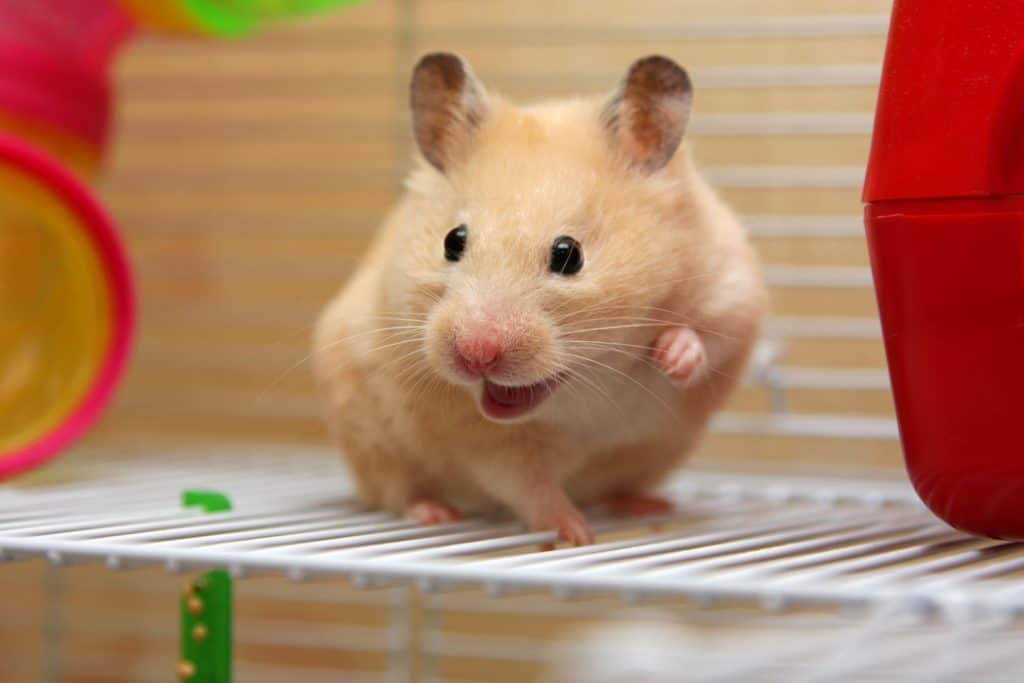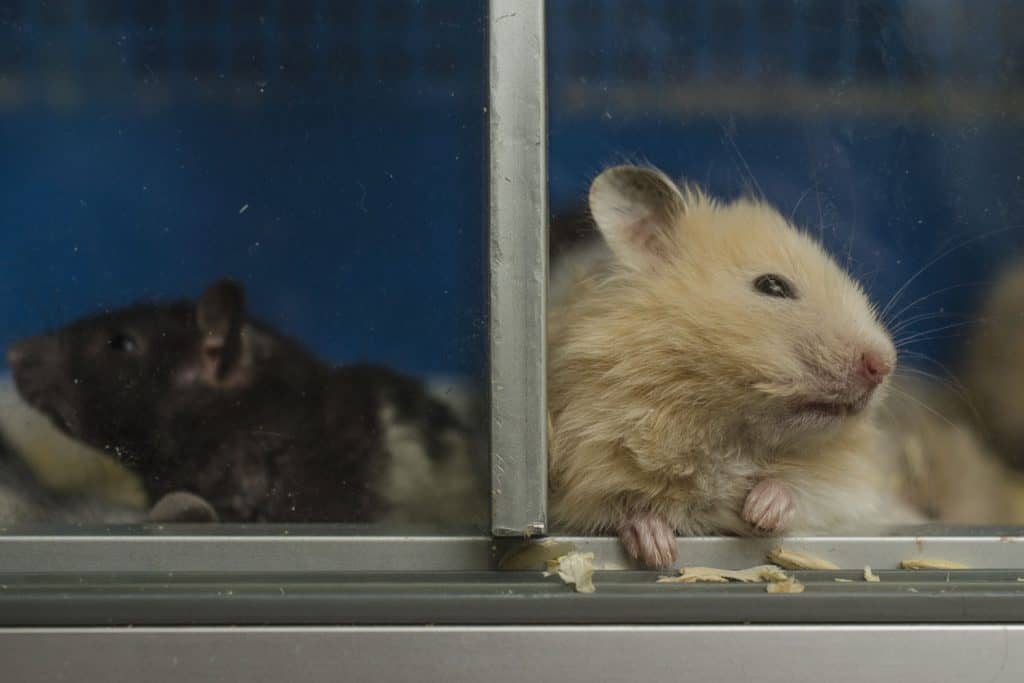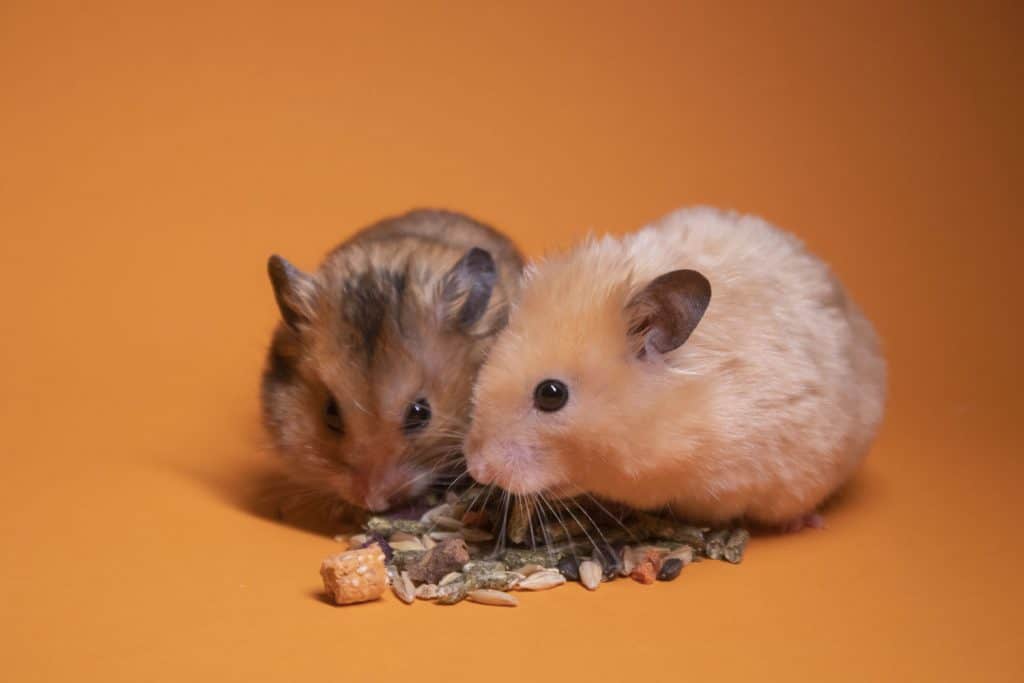 Hamsters are known for being adorable, fluffy, and energetic.
Hamsters are known for being adorable, fluffy, and energetic.
They’re also known for sometimes being strangely aggressive in a way that their owners don’t quite understand.
Owners of more than one hamster can relate to the worry and alarm that comes with seeing their pets brawling and hearing the aggressive squeaking of two hamsters in combat.
Why does this happen and how can a hamster owner stop this behavior?
We’re here with the answer so that you can put your mind at ease.
Syrian (teddy bears) hamsters are very territorial and should always be housed alone.
Never keep two Syrian hamsters in the same cage after they've reached puberty.
Some dwarf hamster breeds are capable of sharing a living space but it needs to be large enough and with plenty of privacy for all hamsters in the cage.
The rest of this article will address fights between dwarf hamsters.
If you have two Syrian hamsters fighting - please separate them immediately into two spacious and well-equipped enclosures.
If you house two or more dwarf hamsters in the same enclosure, you have to realize that there is a chance that they will fight.
However, not every instance of fighting is something to worry about. Especially if the hamsters are
Some hamsters will wrestle together to burn energy or to establish dominance over each other without causing harm, but how can you tell the difference?
And when the wrestling turns to genuine fighting, what can you do, as an owner, to minimize this problem?
Hamster behavior can be tricky to figure out, so let’s dive into the meat of the matter.
Why Hamsters Fight in the First Place
Hamsters are a lot like people in the way that they can sometimes live amicably with another hamster, but not every prospective roommate is compatible.
Dwarf hamsters often live together just fine, but fighting isn’t an uncommon occurrence either.
It's worth mentioning once again that in the case of Syrian hamsters, you should never have them share a space due to their very territorial nature.
If you take one thing from this article, let it be this -
Syrian hamsters are solitary animals. If you're keeping a pair in the same area, get another large cage and separate them as soon as possible.

Even in non-solitary hamsters, space can be an issue. In addition to disagreeing temperaments, hamsters may fight because they don’t have enough space or have become stressed.
Even hamsters who have never shown aggression toward each other before can begin fighting under these circumstances, so it’s important to practice the highest quality of hamster care possible.
Playfighting vs Actual Fighting: Know the Difference
Hamsters will wrestle when a more aggressive hamster tries to bite at the belly of another.
Through a practice known as “appeasement,” the other hamster may appear to disregard the aggressor and thus indicate its surrender before a wrestling match breaks out.
However, if it does not back down, that is when the hamsters might engage each other.

When hamsters wrestle, you will often see them rolling around together in an attempt to overpower one another.
Eventually, a hamster may lay on its back in a show of defeat. When this happens, the wrestling match typically ends.
Sometimes, though, neither hamster wants to give up and that is when things turn into a real fight.
Fighting is, as you likely figure, more aggressive and potentially harmful than wrestling.
When nobody admits defeat in a wrestling match, you will see and hear things coming from the cage that indicate a fight, such as more intense biting and louder squeaking.
If left to their own devices, a hamster fight will end when one hamster flees from the fight altogether.
What to do When Your Hamsters Fight

The fastest way to put an end to a hamster fight is to physically separate them immediately.
However, you should do this with caution. Two riled-up hamsters could accidentally injure their owner when they reach their hands into the enclosure to pull them apart.
Wear gloves when doing this to reduce your risk of being scratched or bitten by your pets.
If you don’t feel comfortable enough to reach into the cage with your hands while your hamsters are fighting, a spritz of water from a spray bottle could motivate them to come apart.
After that, you can pick up one hamster to separate them safely.
Cohabitating hamsters may need some cooling off time, just like humans do when they get into an altercation with another person. This “time out” should be a period of at least a full day.
When you reintroduce them, monitor their behavior very closely in the coming days.
If they don’t interact with each other except to fight, you should strongly consider a permanent separation.
Preventing Hamster Fights

While you cannot control the personalities and relationship between two hamsters, there are some things that you can do to minimize the risk of fighting between these small animals.
Keep these tips in mind when preparing to have cohabitating hamsters but remember: Following all of this advice does not guarantee a peaceful sharing of space.
It is not a failure on the part of the hamster owner if their hamsters simply do not get along.
Consider Breed and Sex
Female dwarf hamsters are known for being more likely to share a space without fighting while males of all breeds have a tendency to be more aggressive with each other.
Syrian hamsters should never be paired in an enclosure with other hamsters, regardless of sex.
Never pair a male and female hamster together, not because they will not get along but because they may get along “too well.”
Unintentional breeding is a very real risk that you take when putting a male and female hamster into the same enclosure.
Keep the Cage Clean

Hamsters are territorial, and smells have a lot to do with that.
Make sure to keep the hamsters’ enclosure clean to avoid a buildup of smells that could stress out your pets.
Their bedding should be changed at least once weekly, with any wet bedding being removed on a daily or near-daily basis to ensure a clean, dry space for your hamsters.
Check out our post about how often to clean a hamster's cage.
Change the Layout
Pairs of hamsters require more space to move around than a single hamster, so the cage should be upsized from what you would normally use for a single hamster.
If an aggressive hamster feels very closed-in and confined, this can result in fighting behaviors.
Try investing in a bigger cage and adding new toys and elements, like wheels and tunnels, to keep your hamsters entertained and ensure that they have their own space.
An alternative to buying a new cage if you feel that yours is already adequately sized is to place a partition in the cage that physically separates the hamsters.
Choose a partition made of glass or clear plastic rather than bars, as hamsters could still attempt to fight each other between the gaps. This allows the hamsters to have companionship without the risk of a fight breaking out.
Check this article for DIY hamster cages and enclosures ideas.
Permanent Separation May be Necessary
Unfortunately, the only way to guarantee that your hamsters won’t go after each other is to keep them separated on a permanent basis and never introduce them to the same enclosure at any time.
Even in the presence of a partition that separates them in the same enclosure, they could still get stressed by seeing one another – especially if one or both hamsters are particularly aggressive.
Entirely separate enclosures could be necessary if your hamsters just cannot get along.
Fighting Between Hamsters is Serious
A fight between two hamsters might not seem that brutal or dangerous because they are small creatures.
However, their teeth can cause serious damage to each other in the throes of a fight. Hamsters have sustained ghastly injuries and have even died as a result of these fights.
Prevention is important in keeping your hamsters safe. It is also vital that you have an understanding of each hamster’s temperament.
If you know that a hamster is especially aggressive, it could save you both a lot of stress to house them separately from your other hamsters from day one.
In conclusion, it’s really all about being attentive and practicing good hamster care.
If you ensure that your hamsters are entertained and living in an enclosure that’s big enough for pairs, you could see a successful cohabitating situation.
However, some hamsters just will not get along. You can’t force it and you shouldn’t feel bad if you have to keep them separate for their own safety.




I have drwaf hamsters, all three came from the same mother, two are females and one is a boy, of course I have the boy in a separate cage, now the girls get along they sleep together but they do tumble and fight but I feel they way they fight one goes on her back when the small one tumbles her then she runs away and play. They squeal but then stop and each one goes their separate way, the cage I recently bought has three levels and a tube on the side, only one of them stays in the tube and the other one climbs over her to get to the upper floors, they are fun to watch because they both try to get on the same wheel when there’s three wheels in the cage, one on each level which the small one try’s all of them, the other one eats, sleeps and sometimes she’ll run around or goes back to her house to sleep. Is that normal? But in the end they both sleep together. I play with all three separately I give them play time in the playpen where they have a sandbox, wheel a tube and an open ball to roll in. So my question is is it normal for them to fight? At least that’s what I see but they don’t bite each other.
We have 2 made winter white dwarf hamsters that have been together as a litter. They have a 40 gallon tank, had mostly two of everything tot (eg wheels, but different ones), and got along really well (eg sleeping together). But once they got to be around 5 months old, one of them started to bully the other. The biggest contention seemed to be a wheel that they both preferred (but we only had one of that type). The squeaking got more frequent at night, with the bully chasing the other that we could tell the bullied one was afraid to go anywhere near the bully. One night I noticed some blood on the bullied one’s back, and even when they did end up sleeping together, the bully would end up picking on the bullied one. That night we put the bully into a separate bin. The separation lasted 3 days, and over that period, we noticed both of them being more despondent and seemingly out of sorts (sad??)
On the fourth night, we introduced them together in a play pen (neutral territory). When the two got together, they both stood on their hind legs and seemingly wanted to fight. We broke it off, and were about to separate them when the most unexpected thing happened. They cuddled together and groomed each other. We were very surprised and observed for quite a bit of time but they were inseparable. So we reintroduced both back in the 40 gallon tank and kept a close eye. We found that the bullied (who had been in the tank during the separation period) dominated the favored wheel. No chasing, no fighting, and eventually both came to share the wheel, and often running in that favored wheel together. And we observed them grooming and huddled together almost all the time. We get the feeling that they’re happier than being separated.
It’s been about 4 days since we reintroduced them and so far so good. I thought I’d share this in case this works for other fighting siblings. My hunch for part of the success was key was getting the bully out of the “home” environment and letting the bullied get his smell more established.
Just for good measure, we’ve ordered another one of the favored wheel.
Would be curious to know what we did right and what else we can do to prevent any future fighting.
Like humans, hamsters need a good old time out. I’m glad they got on after the separation. I usually don’t interfere with a scuffle unless there’s signs that it’s an actual fight. it’s hard to tell sometimes.
So I got three girl hamsters on new year and they were together since young but after few weeks they started fighting. I then separated them because the fought till they bleed but it’s been awhile now and I’m scared to put them back together and I don’t know how to. So can someone please help me on what to do. I would really appreciate it☺️
I’m just wondering if there’s key differences between playing and getting the energy expelled and fighting. I just got my 3 female russian dwarfs after my syrian had passed. They have a bin cage and we do plan to increase the size. I just have noticed two of my 3 girls have been rolling around each other. I separated and checked for injuries but saw nothing. There wasn’t any squeaking or signs of distress. I also have 2 male dwarf hamsters that declanned due to territorial issues. I’ve been keeping an eye on them. However they still sleep together, and don’t seem to chase one another off. I’m hoping its just in play. I keep monitoring on the off chance a separation is needed.